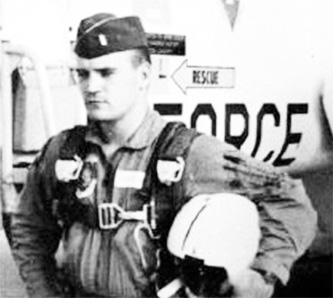“In the early morning of August 9, 1969, 1Lt. Jefferson S. Dotson, pilot, and Capt. Lee Gourley, his rear-seat co-pilot, departed Tuy Hoa Airbase located on the coast of central South Vietnam on a “Misty” Forward Air Control (FAC) mission over the Ho Chi Minh Trail in central Laos.
Lee Gourley had written home early that same day saying that all missions for that day had been scrubbed due to bad weather…
The aircraft Dotson and Gourley flew, the F100 Super Sabre, had been specially modified a few years before to include a second crewman. The F-model, introduced in 1965, had the latest technology in radar signal detectors. The initial shipment of F100F’s were called “Wild Weasel I” and were an important element in several combat operations.
Gourley and Dotson were not on a Wild Weasel mission, however, and on the FAC mission this day, no bombs were loaded. They were to fly low and fast over their objective area and presumably analyze targets for future airstrikes, or assess the potential need for further strikes. FAC reconnaissance missions in the traditional sense were often flown by light observation aircraft rather than fighter/bombers, but the necessary element for this mission was low altitude and high speed, as well as the ability to cover a large territory.
Although there was normally no scheduled air backup or escort on a FAC mission, and Gourley and Jefferson had none, other aircraft which happened to be in the area provide information as to what happened to Dotson and Gourley as they flew near Sepone in Savannakhet Province, Laos.
One passing aircraft intercepted a radio transmission from the F-100F, “We’ve been hit, we’re going to try to get out.” Observers from the passing aircraft then saw the F-100 go up in flames, and observed one fully deployed parachute. (NOTE: The standard ejection called for the rear-seater, Gourley, to make the first ejection, then the pilot, and a fully deployed chute indicated the successful ejection of a crew member.)
Dotson and Gourley were classified Missing in Action. Their families understood that they might have been captured, and like the families of others who were missing, wrote regular letters.
On Wednesday, Sept. 4, 2002 the family received news that Scotty’s remains had been found near the crash site. He was repatriated and is buried at Arlington National Cemetery.
REMEMBERING SCOTTY
According to family members, from the time he was a young boy growing up in Pound, [VA] Scotty had a passion for flying.
“He always wanted to be a fighter pilot,” said Cantrell.
Their father, Otis Edward Dotson Sr., a pilot himself, taught Scotty and his older brother, Buddy, to fly when they were only teen-agers, family members say. Their father later died while the boys were still teens.
He graduated from college in 1966 and joined the Air Force in January 1967 to pursue his dream of becoming a fighter pilot, she said.
Scotty left for Vietnam in the summer of 1968, leaving behind his wife Mary Ann and their 3-month-old daughter, Christa.
As fate would have it, Scotty was stationed at the Phan Rang Air Force Base in South Vietnam, where his older brother Buddy also was stationed. The two brothers spent the next five months serving in Vietnam together. Although the situation was not ideal, it was five months Buddy will treasure forever… In the five months that followed, the brothers became closer than ever, perhaps because they were sharing in a common experience that few can comprehend.
“We had five wonderful months together,” Buddy said. “We had a brotherhood like we had never had before.”
In December 1968, his term of service over, Buddy left Vietnam, and his little brother, behind to return to the United States.
“I hated leaving him there when I came back,” he said…
Prior to leaving Vietnam, Buddy says, he begged his brother not to transfer to the Tuy Hoa Air Force Base because of the dangerous missions the pilots flew from there.
However, he says, Scotty did transfer to Tuy Hoa and it was from there that the fatal mission originated.
MISSING IN ACTION
Buddy was still at the Air Force base in New York when he was notified. At first, he blamed himself. If only he had stayed in Vietnam, he told himself, maybe his brother would not have been killed. If he had stayed, he said, his brother would have stayed with him at Phan Rang and never transferred. He would have never gone on that mission.
However, Buddy says, he eventually came to realize that it was not his fault. There is no guarantee that his brother would be alive today if he had stayed behind in Vietnam with him.
He knows it is not what his brother would have wanted.
REMAINS FOUND
The family learned in Fall 2001 that the U.S. Government had found what they believed to be the crash site. Officials began excavating the site for remains in the fall, but inclement weather kept interfering.
In spring of this year [2002], they found remains. According to Buddy, the remains of the pilot who was with his brother were found at the crash site about 10 miles outside the village of Sepone in the
Savannakhet Province.
His brother’s remains, however, were found buried near a villager’s hut. It is a mystery as to why they were removed from the crash site, he said. (1)
Source: Excerpted from https://www.pownetwork.org/bios/d/d077.htm












